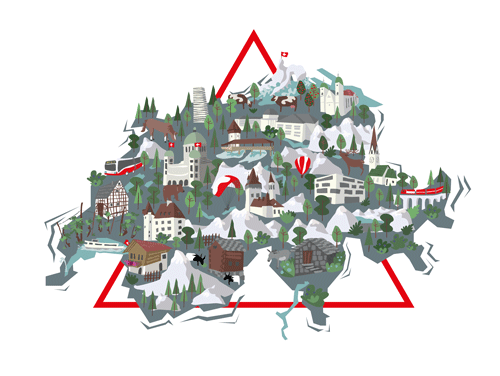Components
Seismic hazard, also referred to as earthquake hazard, is composed of different input data, representing the main components of the current seismic hazard model of Switzerland.
The assessment is based on knowledge of past earthquakes, geology and tectonics, and requires a reference rock model to be determined as a basis for the seismic hazard model. The datasets underlying these factors are combined into a seismic hazard model that can be used to estimate where earthquakes of different magnitudes may occur, how frequently they are expected to happen, and how probable certain levels of ground shaking due to earthquakes are. Recent scientific knowledge and research results are also required in order to reliably assess and estimate the different ground shaking levels in Switzerland.
Tectonics & geology
Earthquakes are caused by a sudden release of stress along faults in the Earth's crust. Their occurrence is determined by regional tectonics, geology and the stress regime in the Earth's crust. Analysing many earthquakes allows conclusions to be drawn about the tectonic stress regime and the depth distribution of earthquakes. Together with information on fault orientation, this provides a basis for estimating the seismic hazard.

Earthquake history
Past earthquake activity and historical earthquake recordings (e.g. location, intensity and impact) are key to understanding and estimating future seismicity and ground shaking. Historical descriptions of an earthquake are translated into a modern description including magnitude, epicentre and depth of focus. To calculate the 2015 seismic hazard model of Switzerland, information on all known damaging earthquakes and their effects up to 1975 was collected and re-evaluated. Since 1975, the Swiss seismic network has enabled comprehensive instrumental monitoring of earthquake activity. The historical and instrumental earthquakes are combined into a catalogue, known as the Earthquake Catalogue of Switzerland (ECOS-09). This can be used to estimate the geographical distribution and probabilities of future earthquakes in Switzerland.

Wave propagation models
The physics related to the radial propagation of seismic waves from the hypocentre (where the fault ruptures) through the Earth's crust, together with data from past earthquakes, allows us to estimate the ground shaking level at a specific location due to an earthquake of a given magnitude.
For the 2015 seismic hazard model, a reference rock model was determined from extensive geophysical measurements at various seismometer sites in Switzerland. The effects of seismic focus, seismic wave propagation and local amplifications were calculated for this purpose. This represents a major advance on the 2004 seismic hazard model and enables the seismic hazard estimate to be calculated for this reference rock while significantly reducing uncertainties in the estimate.

